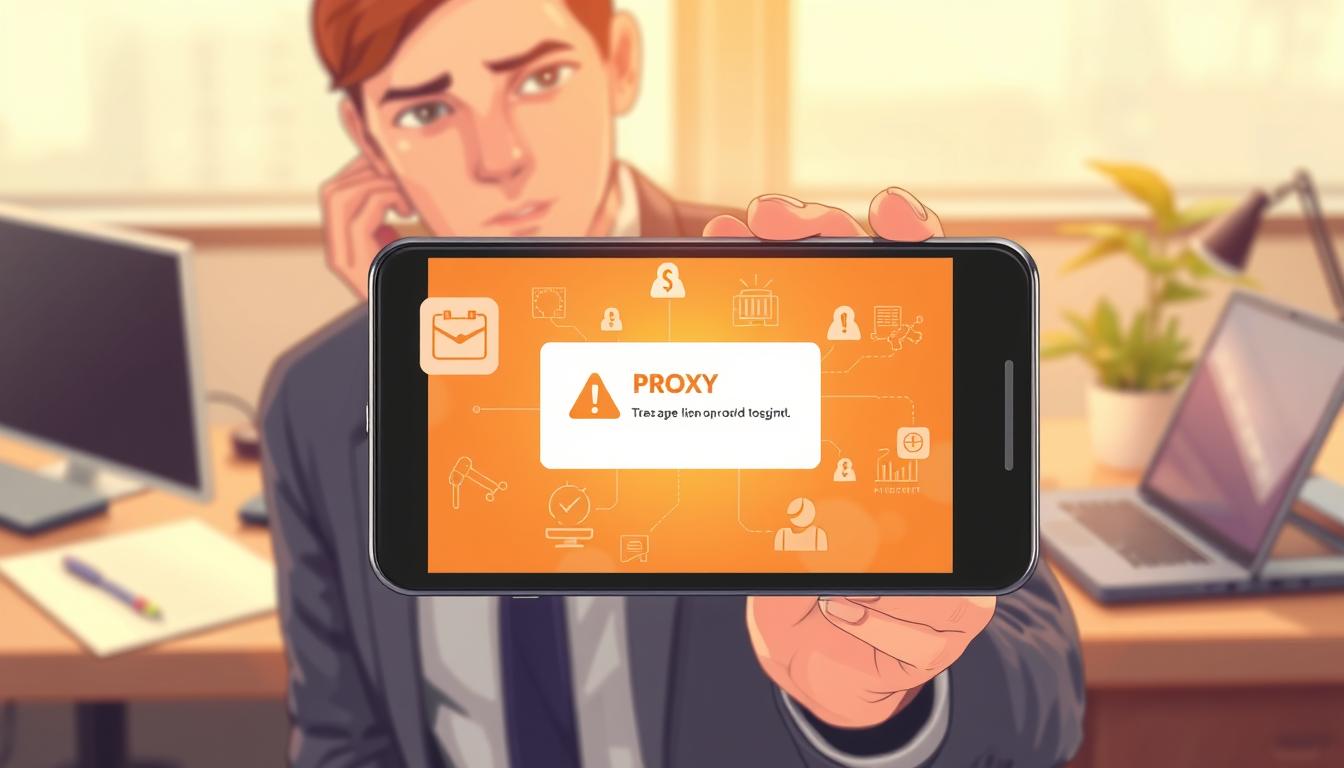FTC disclaimer: This post contains affiliate links and I will be compensated if you make a purchase after clicking on my link.
In the world of game development, tools have become easier to use and more powerful. Whether you’re just starting or have years of experience, the right software is key. But with so many choices, picking the best can be tough.
Imagine finding a collection of tools that change the game. They make creating games easier and open up new ways to be creative. Let’s look at the 11 best game development software of 2024. Each one has special features to help you make games that players will love.
Key Takeaways
- Discover a diverse range of game development software, from professional engines to user-friendly tools.
- Explore the latest advancements in game creation, including the integration of AI-powered tools and assets.
- Understand the key features, pricing, and target audience for each software solution to make an informed decision.
- Learn how to leverage these tools to bring your game ideas to life, regardless of your coding expertise.
- Gain insights into the game development industry and the evolving landscape of tools and technologies.
Introduction to Game Development Software
The world of gaming has changed a lot lately. Now, thanks to affordable game development software, more people can make games. This has made the gaming world more open to everyone.
Today, there are many tools for making games. Each tool is special and helps different people, no matter their skill level or project size.
What is Game Development Software?
Game development software is a wide range of tools for making digital games. These tools help with many parts of game-making, like making characters and physics simulations. They also help with real-time rendering, AI, UI design, and more.
With these tools, developers can work more efficiently. They can turn their ideas into games faster and better.
Why Choosing the Right Tool Matters
Choosing the right game development software is very important. It can greatly affect a game’s quality, how long it takes to make, and if it will be successful. The right tool makes things easier and helps meet project needs.
The wrong tool can cause problems, delays, and not-so-good results. We’ll look at some top game development software soon. We’ll see what makes them special and why they’re good for creators and studios.
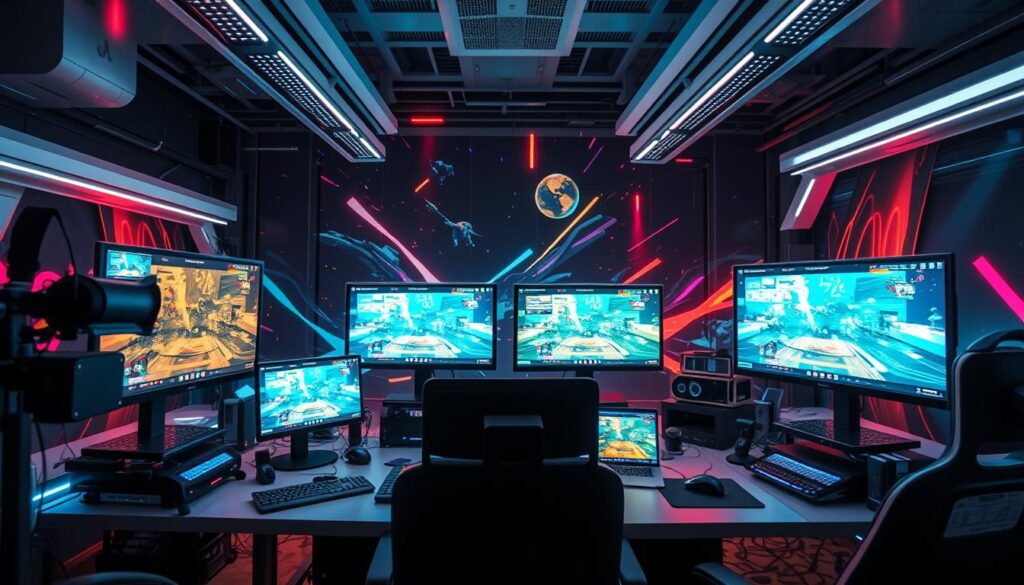
Unity: The Versatile Game Engine
Unity is a top game engine for both experienced and new developers. It’s great for cross-platform development and animation tools. Its easy-to-use interface, big asset store, and strong community help developers make games easily.
Key Features of Unity
Unity works well for both 2D and 3D games. This means creators can make many types of games. From simple 2D games to complex 3D ones, Unity has what you need.
Unity also supports cross-platform development. Games made with Unity can run on many platforms. This includes Android, iOS, Windows, and more. It helps developers reach more people.
Pros and Cons of Using Unity
Unity has a big community and lots of animation tools. The Unity Asset Store has many assets and scripts. This makes adding features to games easier and faster.
But, Unity can be hard to learn for beginners. It has many features, and using them well takes time and practice. Even so, Unity is a great choice for many developers.
Unity is popular because it’s versatile and has great tools. It’s good for all kinds of developers, from small studios to big teams.
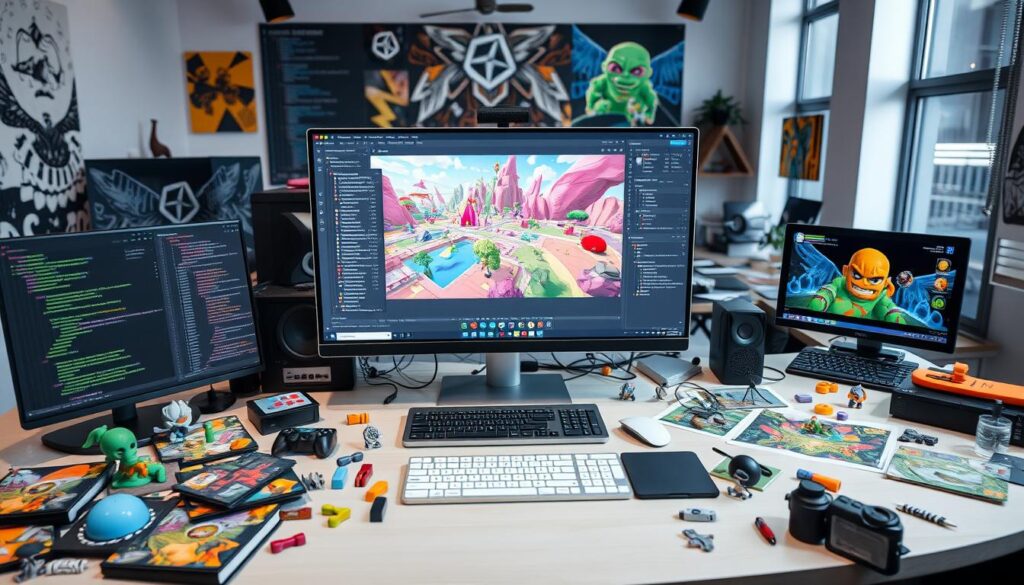
Unreal Engine: For High-End Graphics
Unreal Engine is made by Epic Games. It’s known for amazing graphics and strong tools. Its visual scripting system, Blueprints, lets non-programmers use it. You can make stunning 3D games with it.
Advantages of Unreal Engine
Unreal Engine has cool graphics features. It has real-time ray tracing, Lumen lighting, and Nanite geometry. These help make game worlds look real and feel immersive.
The engine also optimizes performance well. It supports different rendering pipelines. This meets various project needs.
Its World Partition feature is great for big open-world games. It helps developers make large, detailed game spaces. The Unreal Marketplace offers many resources. This makes visual scripting and asset management easier.
Target Audience for Unreal Engine
Unreal Engine is best for big game studios and AAA teams. It’s perfect for making stunning 3D games, especially action, adventure, and open-world ones. But, it’s hard to learn and needs lots of resources. It’s not for small projects or tight budgets.
In short, Unreal Engine is top for its graphics, visual scripting, and big game development. Its advanced features and performance make it great for pushing visual and gameplay limits.
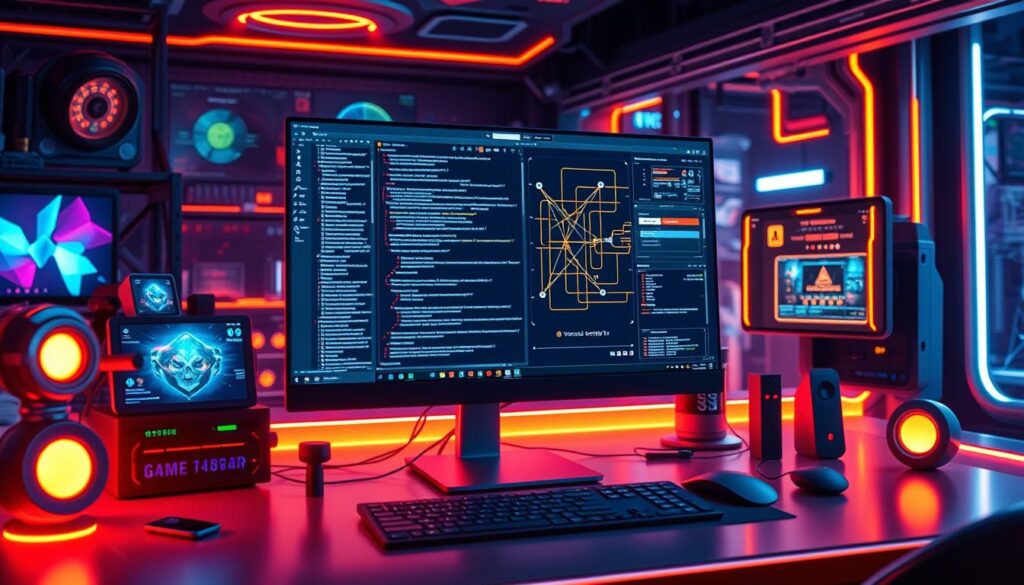
Godot: Open Source and User-Friendly
Godot is a free, open-source game engine. It supports both 2D and 3D game development. It has a unique scene-based architecture and its own scripting language, GDScript, which is like Python.
Godot’s open-source nature and active community make it great for indie developers. It’s perfect for small teams wanting to make games without spending a lot of money.
Unique Features of Godot
Godot has some amazing features:
- It has a strong community with over 80,000 stars on GitHub. This shows it’s popular among developers.
- It’s open-source, thanks to its MIT license. This makes it customizable and appealing.
- It supports multiple programming languages. You can choose from GDScript, C#, and C++.
- It works on many platforms. You can run your games on Windows, macOS, Linux, Android, iOS, and Web.
- It’s easy to learn, thanks to its node-based system. This makes it great for both new and experienced developers.
Ideal Projects for Godot
Godot is perfect for many game development projects. It’s especially good for 2D and indie games. Its open-source nature and user-friendly interface make it great for 2D games like platformers and RPGs.
But Godot can also handle 3D games. This makes it a popular choice for open-source game development and projects needing 2D and 3D support.
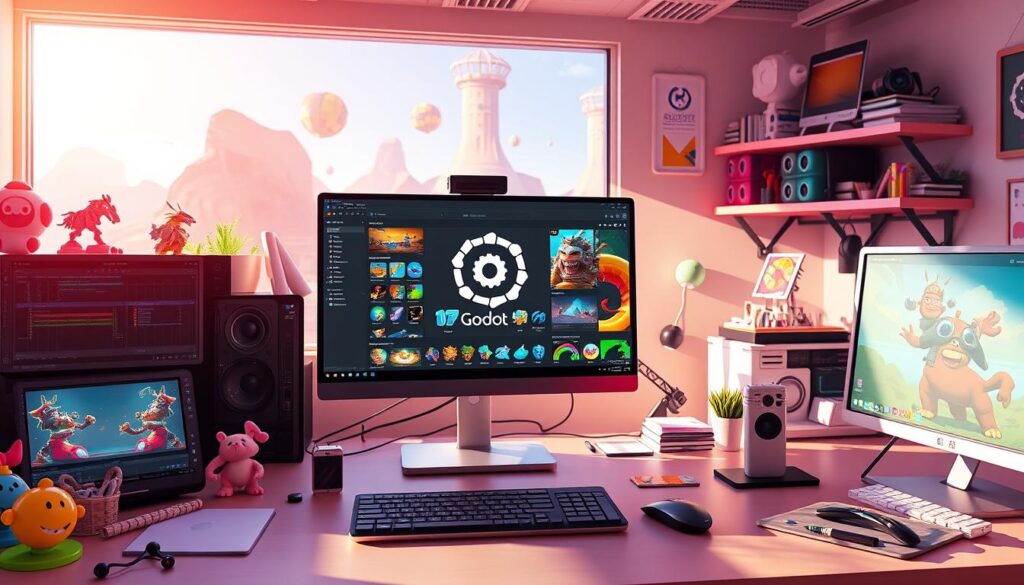
Construct: No Coding Required
Construct is a game engine for those who don’t code. It uses a visual, drag-and-drop interface. This makes creating games easy for many people, from hobbyists to indie studios.
It’s great for making 2D games fast. This has made it popular among creators who want a simple, efficient tool.
How Construct Works
Construct lets users make games without coding. It uses an event-driven system. This means you can set up how game objects interact.
This visual approach makes game development easier. You can focus on the game’s design and visuals. Not on coding and debugging.
Use Cases for Construct
- Rapid prototyping: Construct is perfect for quickly testing game ideas. You can bring your ideas to life in hours or days.
- 2D game development: Construct is great for making 2D games. These can be casual mobile games, browser-based games, or complex arcade games.
- Browser and mobile publishing: Construct lets you export games to many platforms. This includes web browsers and mobile devices. It’s a versatile choice for creators.
Construct might not be the best for 3D games. But, its visual programming and rapid prototyping make it popular. It’s great for those who value ease and speed in game development.
“Construct makes game development accessible to non-programmers, allowing us to quickly prototype and launch 2D games without the overhead of traditional coding.”
– Jane Doe, Indie Game Developer
| Pros | Cons |
|---|---|
| Intuitive visual programming interface | Limited 3D capabilities |
| Rapid prototyping capabilities | Fewer advanced features compared to some other game engines |
| Supports various platforms, including web and mobile | Potentially less flexibility for complex game mechanics |
| Accessible to non-programmers | May require additional tools for asset creation |
GameMaker Studio: 2D Game Focus
If you love making 2D games, GameMaker Studio is a great choice. It’s made for 2D games and is easy to use but powerful.
Why Use GameMaker Studio?
GameMaker Studio has a drag-and-drop interface. This makes it easy for both new and experienced developers. You can start making games fast without getting lost in code. But, it also has a strong scripting language for more control.
The software makes making games faster. It uses a design pattern that saves time. It also lets you control memory well, which is great for quick game development.
Notable Games Made with GameMaker
Many famous indie games were made with GameMaker Studio. “Undertale” and “Hotline Miami” are examples. These games show what GameMaker Studio can do.
“GameMaker Studio’s scripting language and component-oriented development style have been instrumental in bringing our game ideas to life. The ability to quickly prototype and iterate on our concepts has been a game-changer for our studio.”
GameMaker Studio might not be as detailed as 3D engines. But, it’s perfect for 2D games. It’s easy to use and has a big community of developers. It’s a top choice for 2D game development.
CryEngine: Impressive Visuals
CryEngine is famous for its amazing graphics. It’s a top pick for game makers wanting stunning visuals. This engine is great at simulating physics and making 3D graphics that pull players into virtual worlds.
Standout Features of CryEngine
CryEngine shines with its real-time lighting and global illumination. It has a powerful rendering system too. These help developers make game worlds that look amazing.
It also has cool terrain sculpting and texturing. This lets developers make realistic landscapes and natural settings.
CryEngine is versatile, supporting many visual effects. It handles dynamic weather and realistic particle simulations. These add to the game’s immersive and captivating feel.
Target Platforms for CryEngine
CryEngine works on PC, Xbox, and PlayStation. It’s good for all kinds of games, big or small. Developers can use its tools to make games that look great on different devices.
It focuses on photorealistic graphics and advanced physics. CryEngine is a favorite for studios aiming to create amazing visuals and gameplay. Its easy-to-use interface and big asset library help developers make great games.
RPG Maker: For RPG Enthusiasts
RPG Maker is a top choice for those who want to make role-playing games. It was first released in 1992. Over time, it has grown and is now on many platforms like Super Famicom and Windows.
RPG Maker’s Unique Capabilities
RPG Maker is easy to use and comes with lots of pre-made assets. This lets users make 2D RPGs without needing to know how to code. It has a simple event system for adding game logic and mechanics.
The software also has a scripting system. This lets creators customize their games and make them unique.
Community and Support
The RPG Maker community is very active and supportive. The RPG Maker MV community on Steam is especially lively. People love how easy it is to use and the many character creation options.
There are lots of tutorials and resources available. This includes video tutorials, forums, and a big library of downloadable assets. These help users improve their games.
RPG Maker is great for making traditional Japanese-style RPGs. But, its scripting system also lets you create other types of games. Since its release in 2020, RPG Maker MZ has been updated. It’s a powerful tool for bringing role-playing games and scripting system ideas to life.
| Feature | Description |
|---|---|
| User-Friendly Interface | RPG Maker offers a straightforward and intuitive interface, making it accessible for both novice and experienced game developers. |
| Pre-Made Assets | The software includes a vast library of pre-made assets, such as character sprites, tilesets, and sound effects, allowing users to quickly build their games. |
| Event System | RPG Maker’s event system enables users to easily implement game logic and mechanics without extensive coding knowledge. |
| Scripting Capabilities | The software’s scripting system allows for deeper customization, enabling creators to expand beyond the base capabilities and tailor their games to their specific vision. |
| Multiplatform Support | RPG Maker has been available on a wide range of platforms, including consoles, mobile devices, and desktop computers, giving creators the flexibility to publish their games on various platforms. |
Conclusion: Choosing the Best Software for You
Choosing the right game development software is key to your project’s success. Look at your game development workflow and project requirements. Think about the learning curve, community support, and how well it grows with your project.
Factors to Consider
Every game development software has its own strengths. Look at the graphical style, coding needs, and platforms you want to use. Also, check how well it integrates, its documentation, and its overall support system.
Final Thoughts on Game Development Tools
The game development world has many software options, each with its own pros and cons. By thinking about your project’s needs and your team’s skills, you can find the best software. The right tool can help you work more efficiently, improve your game’s look, and give players a great experience.





